Overview
- Brief Narrative
- Intaglio print, Untergang, created by Lea Grundig in 1936 in Nazi Germany. This is number 10 from the series, Krieg Droht. Lea Grundig and her husband, Hans, were dedicated Communists who created anti-Fascist works documenting and protesting conditions under Nazi rule in Dresden. Such works were prohibited under Hitler and the Nazi regime. Lea, 30, was arrested for her resistance art in 1936, but released. She continued working as an artist and was arrested in 1938 for high treason and sentenced to two years in the Dresden Gestapo prison. In December 1939, Lea was released and left for Palestine. Hans, 35, was also arrested in 1936 and 1938, and in 1940, he was imprisoned in Sachenhausen concentration camp. He was released in 1944 and went to the Soviet Union. The couple reunited in 1949 when Lea returned to Dresden.
- Artwork Title
- Untergang
- Alternate Title
- Downfall
- Series Title
- Krieg Droht!
War Threatens - Date
-
creation:
1936
issue: 1972
- Geography
-
creation:
Dresden (Germany)
- Credit Line
- United States Holocaust Memorial Museum Collection
- Signature
- front, on sheet, below image, cursive, pencil : 25/60 Krieg droht! Untergang Lea Grundig 1936
- Contributor
-
Artist:
Lea Grundig
Subject: Lea Grundig
- Biography
-
"I wanted to portray the thousand fears, the perception of the horrible, the subjection of those who are shadowed and persecuted. I wanted to show the dehumanizing process and the struggle of the best against it. And I wanted to warn the world against the war that threatened." Lea Grundig (1958)
Lea Langer was born on March 23, 1906, in Dresden, Germany, into a middle class Orthodox Jewish family. Despite parental objections, she studied at the School of Academy of Arts and Crafts and then the Fine Arts Academy in Dresden from 1922 to 1926. While in school, she met Hans Grundig, another art student. Hans was born in 1901 to working class parents, also in Dresden. Lea and Hans joined the Communist Party in 1926. Her father did not approve of her politics or of Grundig, and sent Lea to sanatoriums in Heidelberg and Vienna, but Hans joined her in both cities. In 1928, she and Hans married. They lived in the poor, working class area of Dresden. Lea and Hans were founding members of the Dresden chapter of the Revolutionary German Artists' Association (ASSO) and worked with the Linkskurve theater group. Lea and Hans produced drawings and posters for the Communist Party, but neither could find steady work during the Depression. Lea did linocuts of mother and child images which were widely distributed. She was influenced by the humanistic work of Kathe Kollwitz and the anti-war work of Otto Dix. Her expressionistic style blended elements of her Orthodox Jewish background, social realism, and her deep political involvement in works inspired by the passionate belief that art that would change the world around her.
Hitler assumed power in Germany on January 30, 1933. By summer, the dictatorship was firmly in control. Opposing parties were outlawed and civil rights were abolished. Resistance art was deemed dangerous and Lea and Hans were prohibited from working as artists. The government established a Reich Culture Chamber to control all aspects of German culture. In the Third Reich, the only purpose of art was to glorify Nazi-determined German virtues. Grundig defied the prohibition and between 1933 and 1939, she created three powerful series of protest art: Der Jude ist schuld [The Jew is Guilty], Unterm Hakenkruz [Under the Swastika], and Krieg Droht [War Threatens!] Her work opposed Nazi propaganda by depicting humane scenes of daily Jewish life and the inhumane effects of raids and mass emigration. She wished to show conditions as they really were and to warn people of the bleak future threatening everyone. She worked primarily in intaglio techniques, such as etching and drypoint. Lea was arrested in 1936, but soon released. She was arrested again in 1938, this time for high treason, and sentenced to two years in Dresden's Gestapo prison. After her release from prison, Lea emigrated to Palestine in December 1939 and produced a series of prints depicting the horrors of the ghettos, prisons, and camps in Nazi-dominated Europe. Germany surrendered on May 7, 1945. Of the nearly 150 prints she created in Germany, 114 survived the war.
In 1949, Lea returned to Dresden in the communist ruled German Democratic Republic (GDR / East Germany). She reunited with her husband. Hans, a painter and graphic artist, also had created works that protested the Nazi regime and its brutish rule, based on terror. He had been imprisoned in Sachsenhausen concentration camp from 1940-1945. Lea continued to create political works about the Holocaust, including some based on Hans's ordeal, as well as on contemporary concerns, such as atomic warfare. In 1951, Lea became a professor at the Fine Arts Technical University in Dresden in the communist ruled German Democratic Republic (GDR / East Germany). She was elected to membership in the Academy of Art and served as president of the Association of GDR Artists. She remained politically active and was a member of the Central Committee of the SED, a major political party. Hans, 57, died in 1958, the same year his autobiography was published. Lea, 71, died in October 1977.
Physical Details
- Language
- German
- Classification
-
Art
- Category
-
Prints
- Object Type
-
War in art (lcsh)
- Physical Description
- Drypoint etching on heavy wove cream paper with an expressionist image of a group of nude men and women falling off a black cliff in the upper right corner. They have outspread arms and panicked expressions. A man in the back is being pushed forward. Two figures are crouched near the front, trying not to fall. Two men have fallen directly below the cliff and 3 in the lower left. There is a woman with her arms over her head and another woman clinging to her waist, with a doubled over man to their left. The background is indistinct and shaded.
- Dimensions
- pictorial area: Height: 13.000 inches (33.02 cm) | Width: 9.750 inches (24.765 cm)
overall: Height: 21.000 inches (53.34 cm) | Width: 16.625 inches (42.228 cm) - Materials
- overall : wove paper, ink
- Inscription
- front, lower right corner, pencil : 94
reverse, lower right corner, pencil : 400.-
Rights & Restrictions
- Conditions on Access
- No restrictions on access
- Conditions on Use
- Restrictions on use
Keywords & Subjects
- Topical Term
- Fascism and art. Holocaust, Jewish (1939-1945), in art. Jewish refugees--Palestine. Jewish women artists--Germany--Dresden. Jews--Persecution--Germany. Political prisoners--Germany--Dresden. Politics in art.
- Geographic Name
- Germany--Social conditions--1933-1945--Pictorial works.
- Personal Name
- Grundig, Lea Langer, 1906-1977.
Administrative Notes
- Legal Status
- Permanent Collection
- Provenance
- The etching was acquired by the United States Holocaust Memorial Museum in 1987.
- Funding Note
- The cataloging of this artifact has been supported by a grant from the Conference on Jewish Material Claims Against Germany.
- Record last modified:
- 2024-01-19 08:22:56
- This page:
- https://collections.ushmm.org/search/catalog/irn521153
Download & Licensing
In-Person Research
- By Appointment
- Request 21 Days in Advance of Visit
- Plan a Research Visit
- Request to See This Object
Contact Us
Also in Lea Grundig collection
The collection consists of fourteen etchings issued in the 1970s of drawings created by Lea Grundig from 1934-1936 for three different series: Der Jude ist schuld [The Jew is guilty]; Unterm hakenkreuz [Under the swastika]; and Krieg droht [War threatens] to document and protest the Nazi regime and the persecution of Jews in Nazi Germany.
Date: 1934-1973

Drypoint etching by Lea Grundig of a woman watching children play
Object
Intaglio print, Judengasse, created by Lea Grundig in 1934 in Nazi Germany. This is a print in the protest series, Unterm Hakenkreuz. It depicts a woman watching children play and Orthodox Jewish men crossing Jew's Alley in Dresden. Lea Grundig and her husband, Hans, were dedicated Communists who created anti-Fascist works documenting and protesting conditions under Nazi rule in Dresden. Such works were prohibited under Hitler and the Nazi regime. Lea, 30, was arrested for her resistance art in 1936, but released. She continued working as an artist and was arrested in 1938 for high treason and sentenced to two years in the Dresden Gestapo prison. In December 1939, Lea was released and left for Palestine. Hans, 35, was also arrested in 1936 and 1938, and in 1940, was imprisoned in Sachenhausen concentration camp. He was released in 1944 and went to the Soviet Union. The couple reunited in 1949 when Lea returned to Dresden.
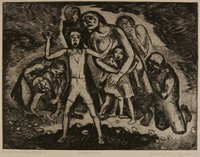
Drypoint etching by Lea Grundig of a Jewish family under attack
Object
Intaglio print, Pogrom, created in by Lea Grundig in 1935 in Nazi Germany. It is number 5 of 75, in the series Der Jüde ist schüld. It depicts a young boy, standing terrified and protective, in front of a huddled family group. Lea Grundig and her husband, Hans, were dedicated Communists who created anti-Fascist works documenting and protesting conditions under Nazi rule in Dresden. Such works were prohibited under Hitler and the Nazi regime. Lea, 30, was arrested for her resistance art in 1936, but released. She continued working as an artist and was arrested in 1938 for high treason and sentenced to two years in the Dresden Gestapo prison. In December 1939, Lea was released and left for Palestine. Hans, 35, was also arrested in 1936 and 1938, and in 1940, was imprisoned in Sachenhausen concentration camp. He was released in 1944 and went to the Soviet Union. The couple reunited in 1949 when Lea returned to Dresden.
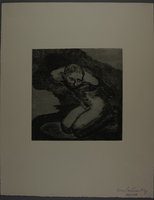
Drypoint etching by Lea Grundig of a bound naked prisoner on his knees
Object
Intaglio print, Knieender Gefangener, created by Lea Grundig in 1935 in Nazi Germany. From the series, Der Jüde ist Shüld, it depicts a nude male prisoner on his knees. Grundig's husband Hans said the image represents a Jewish man who owned a small cigar store on Strehlener Street. Signs with the word "Jew" were placed on his store, and no one would shop there, even those who did not support the anti-Jewish boycott, because they were scared. A World War I hero, the man was taken away, presumably by the Nazis, and killed. Lea Grundig and her husband, Hans, were dedicated Communists who created anti-Fascist works documenting and protesting conditions under Nazi rule in Dresden. Such works were prohibited under Hitler and the Nazi regime. Lea, 30, was arrested for her resistance art in 1936, but released. She continued working as an artist and was arrested in 1938 for high treason and sentenced to two years in the Dresden Gestapo prison. In December 1939, Lea was released and left for Palestine. Hans, 35, had also been arrested in 1936 and 1938, and in 1940, he was imprisoned in Sachenhausen concentration camp. He was released in 1944 and went to the Soviet Union. The couple reunited in 1949 when Lea returned to Dresden.

Drypoint etching by Lea Grundig of a man wrapped in rope up to his neck
Object
Intaglio print, Er wird sich befreien, created by Lea Grundig in 1936 in Nazi Germany. It is number 20 from the series, Unterm Hakenkreuz. Lea Grundig and her husband, Hans, were dedicated Communists who created anti-Fascist works documenting and protesting conditions under Nazi rule in Dresden. Such works were prohibited under Hitler and the Nazi regime. Lea, 30, was arrested for her resistance art in 1936, but released. She continued working as an artist and was arrested in 1938 for high treason and sentenced to two years in the Dresden Gestapo prison. In December 1939, Lea was released and left for Palestine. Hans, 35, was also arrested in 1936 and 1938, and in 1940, was imprisoned in Sachenhausen concentration camp. He was released in 1944 and went to the Soviet Union. The couple reunited in 1949 when Lea returned to Dresden.

Drypoint etching by Lea Grundig of a man threatened by the hands of unseen people
Object
Intaglio print, Verhor, created by Lea Grundig in 1936 in Nazi Germany. This is number 23 from the series, Unterm Hakenkreuz. Lea Grundig and her husband, Hans, were dedicated Communists who created anti-Fascist works documenting and protesting conditions under Nazi rule in Dresden. Such works were prohibited under Hitler and the Nazi regime. Lea, 30, was arrested for her resistance art in 1936, but released. She continued working as an artist and was arrested in 1938 for high treason and sentenced to two years in the Dresden Gestapo prison. In December 1939, Lea was released and left for Palestine. Hans, 35, was also arrested in 1936 and 1938, and in 1940, was imprisoned in Sachenhausen concentration camp. He was released in 1944 and went to the Soviet Union. The couple reunited in 1949 when Lea returned to Dresden.

Drypoint etching by Lea Grundig of a white draped figure running during an aerial attack
Object
Intaglio print, Angst, created by Lea Grundig in 1936 in Nazi Germany. It is number 2 from the series, Krieg Droht. It features a woman covered in a white cloth, running in a dark landscape with large black birds and airplanes above. Lea Grundig and her husband, Hans, were dedicated Communists who created anti-Fascist works documenting and protesting conditions under Nazi rule in Dresden. Such works were prohibited under Hitler and the Nazi regime. Lea, 30, was arrested for her resistance art in 1936, but released. She continued working as an artist and was arrested in 1938 for high treason and sentenced to two years in the Dresden Gestapo prison. In December 1939, Lea was released and left for Palestine. Hans, 35, was also arrested in 1936 and 1938, and in 1940, he was imprisoned in Sachenhausen concentration camp. He was released in 1944 and went to the Soviet Union. The couple reunited in 1949 when Lea returned to Dresden.

Drypoint etching by Lea Grundig of lifeless figures spread over the earth
Object
Intaglio print, So wird es sein I, created by Lea Grundig in 1936 in Nazi Germany. It is number 11 from the series, Krieg Droht. It depicts an apocalyptic landscape scattered with dead and dying human figures. Lea Grundig and her husband, Hans, were dedicated Communists who created anti-Fascist works documenting and protesting conditions under Nazi rule in Dresden. Such works were prohibited under Hitler and the Nazi regime. Lea, 30, was arrested for her resistance art in 1936, but released. She continued working as an artist and was arrested in 1938 for high treason and sentenced to two years in the Dresden Gestapo prison. In December 1939, Lea was released and left for Palestine. Hans, 35, was also arrested in 1936 and 1938, and in 1940, was imprisoned in Sachenhausen concentration camp. He was released in 1944 and went to the Soviet Union. The couple reunited in 1949 when Lea returned to Dresden.
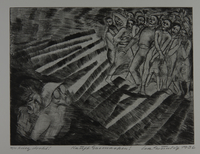
Drypoint etching by Lea Grundig of people caught in a gas attack
Object
Intaglio print, Kauft Gasmasken!, created by Lea Grundig in Nazi Germany in 1936. This is number 3 from the series, Krieg Droht. Lea Grundig and her husband, Hans, were dedicated Communists who created anti-Fascist works documenting and protesting conditions under Nazi rule in Dresden. Such works were prohibited under Hitler and the Nazi regime. Lea, 30, was arrested for her resistance art in 1936, but released. She continued working as an artist and was arrested in 1938 for high treason and sentenced to two years in the Dresden Gestapo prison. In December 1939, Lea was released and left for Palestine. Hans, 35, was also arrested in 1936 and 1938, and in 1940, was imprisoned in Sachenhausen concentration camp. He was released in 1944 and went to the Soviet Union. The couple reunited in 1949 when Lea returned to Dresden.
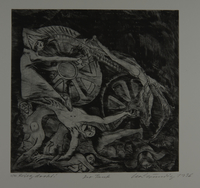
Drypoint etching by Lea Grundig of dead bodies wrapped around tank tread
Object
Intaglio print, Der Tank, created by Lea Grundig in Nazi Germany in 1936. This is number 7 from the series, Krieg Droht (War Threatens). Lea Grundig and her husband, Hans, were dedicated Communists who created anti-Fascist works documenting and protesting conditions under Nazi rule in Dresden. Such works were prohibited under Hitler and the Nazi regime. Lea, 30, was arrested for her resistance art in 1936, but released. She continued working as an artist and was arrested in 1938 for high treason and sentenced to two years in the Dresden Gestapo prison. In December 1939, Lea was released and left for Palestine. Hans, 35, had also been arrested in 1936 and 1938, and in 1940, he was imprisoned in Sachenhausen concentration camp. He was released in 1944 and went to the Soviet Union. He returned after the war ended in May 1945. The couple was reunited in 1949 when Lea returned to Dresden.
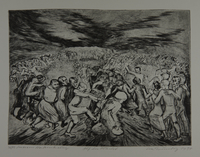
Drypoint etching by Lea Grundig of people trapped and running in circles
Object
Intaglio print, Die flucht Beginnt, created by Lea Grundig in 1934 in Nazi Germany. It is from the series, Unterm Hakenkreuz. It depicts a huge crowd of figures running in panicked, chaotic circles. Lea Grundig and her husband, Hans, were dedicated Communists who created anti-Fascist works documenting and protesting conditions under Nazi rule in Dresden. Such works were prohibited under Hitler and the Nazi regime. Lea, 30, was arrested for her resistance art in 1936, but released. She continued working as an artist and was arrested in 1938 for high treason and sentenced to two years in the Dresden Gestapo prison. In December 1939, Lea was released and left for Palestine. Hans, 35, was also arrested in 1936 and 1938, and in 1940, was imprisoned in Sachenhausen concentration camp. He was released in 1944 and went to the Soviet Union. The couple reunited in 1949 when Lea returned to Dresden.
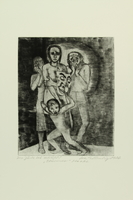
Drypoint etching by Lea Grundig of a group of people hiding their faces
Object
Intaglio print, Stürmermaske, created by Lea Grundig in 1936 in Nazi Germany. It is number 4 from the series, Der Jüde ist schüld. The title refers to Der Stürmer, a pro--Nazi, virulently antisemitic newspaper published by Nazi Party member, Julius Streicher. Its slogan was "Die Juden sind unser unglucic" (The Jews are our misfortune). Lea Grundig and her husband, Hans, were dedicated Communists who created anti-Fascist works documenting and protesting conditions under Nazi rule in Dresden. Such works were prohibited under Hitler and the Nazi regime. Lea, 30, was arrested for her resistance art in 1936, but released. She continued working as an artist and was arrested in 1938 for high treason and sentenced to two years in the Dresden Gestapo prison. In December 1939, Lea was released and left for Palestine. Hans, 35, was also arrested in 1936 and 1938, and in 1940, was imprisoned in Sachenhausen concentration camp. He was released in 1944 and went to the Soviet Union. The couple reunited in 1949 when Lea returned to Dresden.

Drypoint etching by Lea Grundig of a frightened crowd watching storm clouds
Object
Intaglio print, Krieg Droht!, created by Lea Grundig in 1935 in Nazi Germany. It is number 1 from the series, Krieg droht. Lea Grundig and her husband, Hans, were dedicated Communists who created anti-Fascist works documenting and protesting conditions under Nazi rule in Dresden. Such works were prohibited under Hitler and the Nazi regime. Lea, 30, was arrested for her resistance art in 1936, but released. She continued working as an artist and was arrested in 1938 for high treason and sentenced to two years in the Dresden Gestapo prison. In December 1939, Lea was released and left for Palestine. Hans, 35, was also arrested in 1936 and 1938, and in 1940, was imprisoned in Sachenhausen concentration camp. He was released in 1944 and went to the Soviet Union. The couple reunited in 1949 when Lea returned to Dresden.
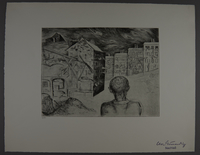
Drypoint etching by Lea Grundig of an isolated figure staring at a building
Object
Intaglio print, Illegal, created by Lea Grundig in 1936 in Nazi Germany. This is from the series, Unterm Hakenkreuz. It depicts a forelorn figure in a barren cityscape. Lea Grundig and her husband, Hans, were dedicated Communists who created anti-Fascist works documenting and protesting conditions under Nazi rule in Dresden. Such works were prohibited under Hitler and the Nazi regime. Lea, 30, was arrested for her resistance art in 1936, but released. She continued working as an artist and was arrested in 1938 for high treason and sentenced to two years in the Dresden Gestapo prison. In December 1939, Lea was released and left for Palestine. Hans, 35, was also arrested in 1936 and 1938, and in 1940, he was imprisoned in Sachenhausen concentration camp. He was released in 1944 and went to the Soviet Union. The couple reunited in 1949 when Lea returned to Dresden.



